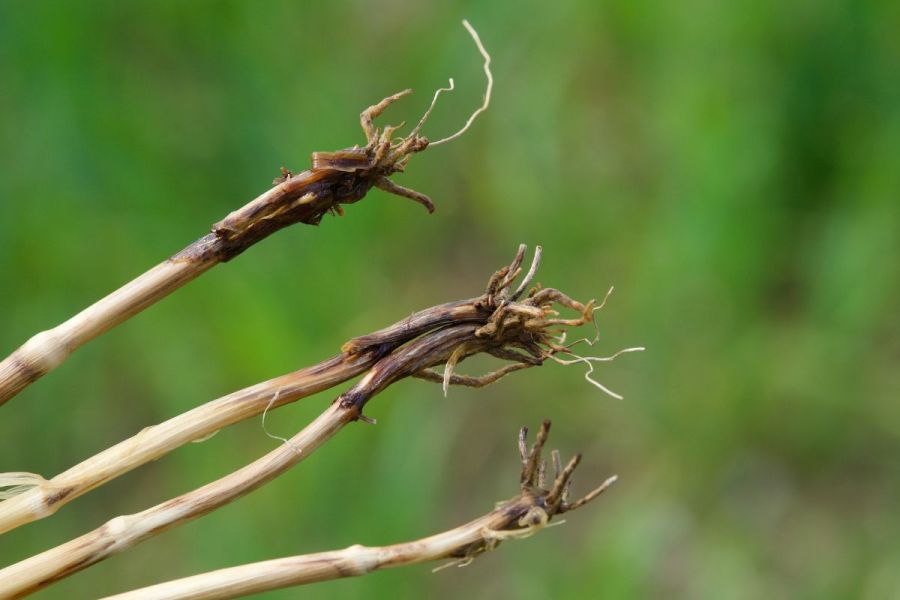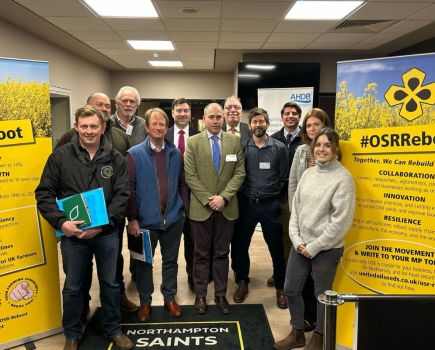Wet weather, mild temperatures and high grassweed burdens this season are set to boost the build-up of the take-all fungus in soils. CPM explores the latest research to find out more.
“If these cousins of take-all enter into the roots first, they stop the take-all fungus getting in; we call it the family feud.”
By Rob Jones
Take-all is considered the most important root disease of wheat worldwide reducing yields by up to 50% in high disease pressure situations, yet options for its control are limited.
With silthiofam in seed treatment Latitude – the only fungicide currently available for use against the disease – and limited varietal tolerance, it means rotational strategies combined with later drilling dates are essential for take-all management.
However, considerable progress is being made in the understanding of take-all, aided by the application of molecular techniques to study the fungus alongside developments in crop genetics and soil microbiome analysis.
Following recent work on the genetics and genomics of the take-all fungus, scientists are hopeful that a fungal ‘family feud’ may provide a route to limiting the impact of this often hidden disease of cereals.
And this is particularly prevalent because this season is already on track to be one in which levels of take-all inoculum and infections will build substantially, although how much damage the disease inflicts on root systems and final yields will depend on weather conditions through to harvest.
Take-all symptoms were starting to appear in trials at Rothamsted Research in Hertfordshire in mid-June, says Dr Kim Hammond-Kosack, a molecular plant pathologist at the institute.
Last autumn’s wet weather followed by a mild winter and wet spring – a weather pattern seen with increasing frequency – represent a high-risk combination for take-all development in soil and subsequent root infections, explains Kim.
She draws a comparison with the 2021-2022 season, which saw high levels of take-all, although disease symptoms came in late and were masked by crop senescence during a hot spell later in the summer.
“Most farmers didn’t see the take-all patches even though the disease level was up at 80-90% that year. This year, if the cooler weather continues, they’ll perhaps see a little height depression in their crops but possibly not a proper take-all patch,” says Kim.
Climate change is expected to increase take-all risk in areas where autumns and winters become milder and wetter. Studies at Rothamsted have compared the effects of different weather patterns and extreme weather events on take-all infections and disease severity across several seasons.
The take-home message from these studies is that warmer, wetter winters and milder, wetter springs followed by any type of summer weather – including extreme heat – can increase take-all infections and disease severity, says Kim.
Further research underway at Rothamsted is focused on crop genetics, including screening for new sources of resistance. One line sourced from the 1930s A. E. Watkins collection of wheat landraces – Watkins 777 – has been evaluated under field conditions and found to display good root resistance to take-all under moderate and high disease pressure in a third wheat situation.
Tall and low yielding, Watkins 777 isn’t a commercial cultivar and so was crossed with spring wheat Paragon to produce a biparental mapping population used to map the genetic regions associated with disease resistance at specific locations in the wheat genome.
“We now have one very large QTL (quantitative trait loci) – one region of the genome – where it seems this resistance resides. We have markers to each side of this QTL and as we narrow this interval, the exact genes conferring resistance can be revealed, while commercial breeders can start to use the original diagnostic markers to cross the new trait into elite wheat breeding programmes.
“That’ll mean the Watkins 777 resistance should end up coming into commercial varieties as an introgression in about five or six years’ time,” suggests Kim.
Another area of research, which she admits to being ‘very excited about’, is work on the genetics and genomics of the take-all fungus family. This has revealed that Gaeumannomyces tritici (Gt), the fungal pathogen responsible for take-all infection, has a non-pathogenic relative Gaeumannomyces hyphopodiodies (Gh), which is unable to penetrate through to the root cortex. And, unlike Gt, doesn’t cause damage to roots.
According to Kim, infection of roots with Gh has been shown to be beneficial in reducing take-all infection. Although why this happens isn’t clear, it appears reduced infection may be correlated with up regulation in several defence genes.
“If these close cousins of take-all enter into the roots first, they stop the take-all fungus getting in; we call it the ‘family feud’,” says Kim.
Sequencing the genomes of Gt and Gh strains will enable analysis of the populations of each fungus in soils using genetic markers. Ultimately, it may be possible for growers or agronomists to conduct a simple diagnostic test to identify which fungus is present which could help inform rotational planning.
On farm, the take-all thread runs through several facets of agronomy, including rotation, drilling date and grassweed burden, each of which require consideration as new season plans are shaped.
But it’s likely rotations have been severely disrupted this season with the expectation of a considerable quantity of held-over seed available, together with questions around the viability of break crops whereas a swing back into winter cereals and wheat in particular, is anticipated.
The legacy of the difficult 2023 autumn is also expected to compel growers to drill earlier which will only exacerbate the take-all risk, says Agrii’s David Leaper.
As always, much depends on the weather – should conditions remain relatively damp, take-all inoculum will continue to build and there’s a risk winter cereals will be drilled into a high inoculum base, he says.
“The weather has implications not just for the current season but also in terms of what the impact of take-all could be next year. This pattern of wetter soils and warmer temperatures means we’re getting a big take-all build.
“If you drill earlier, whether it’s first or second wheat, it’s going to have an implication on the dynamics of take-all; your take-all build is going to be exacerbated,” he warns.
Close to 15% of the winter wheat seed sold by Agrii is treated with Latitude, adds David. “It’s far from a niche treatment and it does show the commitment to second wheats – there’s quite a hectarage out there,” he says.
While second wheat plantings for Harvest 2024 were hit by last autumn’s wet weather and difficult drilling conditions, the area is likely to recover to more typical levels for Harvest 2025, he suggests.
“If growers were struggling to drill first wheat last autumn, then they were definitely struggling with second wheat. I suspect the second wheat area will probably bounce back to where it was previously,” adds David.
Currently, as the only chemical option for use in take-all management, Latitude should be used in conjunction with cultural approaches, encompassing tillage, rotation, drilling date, crop nutrition and variety choice in an IPM approach to disease management.
With cultivations, it might be expected that reduced tillage would lead to increased levels of take-all because seedling roots are in close contact with debris from the previous crop, but the reality is the additional consolidation afforded by a direct drill or min-till approach is beneficial, says David.
“A lot of the work that came out of the Arable Research Centres back in the 1990s showed that one of the worst things to do [in creating favourable conditions] for take-all is to open up the soil and introduce a lot of air. Consolidation in itself is quite good.”
Certain grassweeds including ryegrass provide a host for the take-all fungus, contributing to the build-up of inoculum, while blackgrass has only a minimal effect on build up other than the fact it influences drilling date and rotation.
Indeed blackgrass, much in evidence this season, is likely to be the main driver when it comes to bringing rotations back on track this autumn, suggests David.
“Where you have blackgrass on the farm your rotation is driven by it: what you drill, when you drill, and how you manage the crop. That almost moves you out of the traditional approach to rotation.
“The reality is we’re going to have to live with a more fragmented approach to our rotations, especially where we have ryegrass or blackgrass on the farm, or indeed, if the climate is dictating what fields you can cultivate and drill.
“I think farmers are quite resilient and as long as they have the right information on the right varieties, to put in at the right time and manage them to cover their weaknesses, they’ll pull their rotations around quite quickly,” he says.
One aspect of take-all management that’s possibly overlooked is the impact of challenges arising outside of cereal crops, comments Certis Belchim’s Adam Nears. “We’re seeing an awful lot of grassweeds in break crops and spring crops this season and they’re going to carry over take-all inoculum.
“That elevates the risk for crops going into the ground this autumn and I think the danger is while growers understand that in a second or third wheat situation take-all is a factor to consider, what will catch them out is that break crops or SFI options haven’t been clean and won’t have been a true break,” says Adam.
He believes an early start to the autumn 2024 drilling campaign is almost inevitable but highlights Latitude’s value as a tool in managing drilling dates. “We always see after a very wet autumn that drilling gets pulled forward by a week to 10 days the following year but, in these situations, days really do matter, whether in blackgrass control or take-all risk,” he says.
Bringing drilling forward with unprotected seed will elevate the take-all risk, but Latitude can be used to help manage the drilling window and offset that risk, he adds, possibly even in a first wheat where grassweeds haven’t been well-controlled in the preceding break crop or where the field has a history of take-all.
“I’d have no hesitation in advocating the use of Latitude in a first wheat situation where grassweeds haven’t been controlled and where there’s the opportunity for inoculum to build up,” says Adam.
With a typical yield response of 0.2t/ha from Latitude use in a first wheat situation, compared with a more typical 0.55t/ha in a second wheat it is, however, important first to consider how wheat is being priced in the budget, he adds.
“If you’ve forward sold wheat at £210/t plus a £60-70/t milling premium, then 0.2/ha is probably worth chasing economically. But if we’re talking about basic feed wheat at £190/t, perhaps even £160/t if you sold some back in March just to get something on the books, then you have a very different equation.
“You have to think about your market and what the value of your wheat is going to be, what the take-all risk is and whether Latitude is going to give you an economic return on investment, and to help with that we have the Latitude Cost Benefit Calculator for growers to use,” concludes Adam.
This article was taken from the latest issue of CPM. Read the article in full here.
For more articles like this, subscribe here.
Sign up for Crop Production Magazine’s FREE e-newsletter here.




